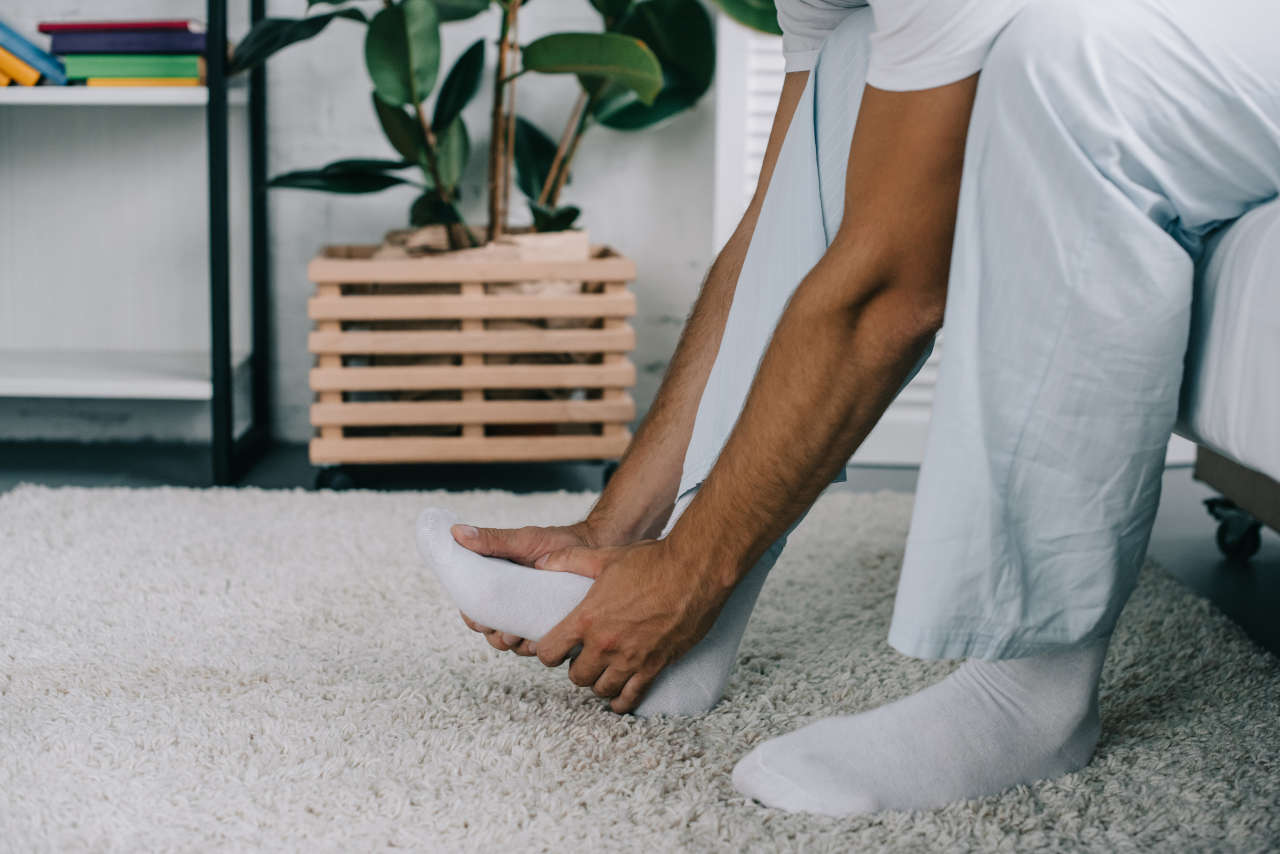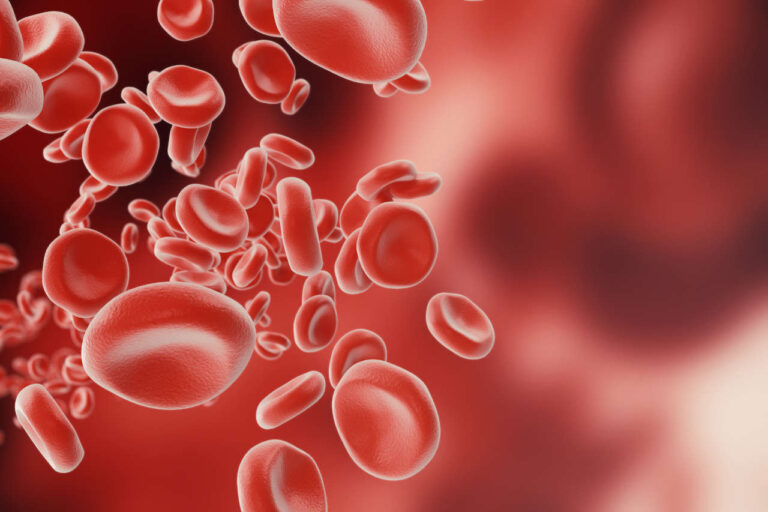
- Small fiber neuropathy symptoms include burning, stabbing pain, tingling, numbness, and hypersensitivity, often starting in the feet and legs before moving upward.
- Autonomic SFN symptoms such as dizziness, dry eyes/mouth, abnormal skin color, and blood pressure issues indicate nerve involvement beyond sensation.
- Symptoms can progress from mild early signs to severe pain.
- Early recognition of symptoms is crucial for timely treatment.
Get Copay Assistance Now
Small fiber neuropathy (SFN) is a nerve condition with distinct symptoms that can be challenging to recognize. These symptoms often emerge gradually and vary from person to person.
However, understanding them is crucial for diagnosing the disease early and managing it effectively. Today, we will examine the various symptoms of SFN to help you understand what to watch for with this disease.
Understanding Small Fiber Neuropathy
The neuropathy of small fibers is a type of peripheral neuropathy. Peripheral neuropathies are conditions that influence the peripheral nervous system, which consists of the nerves located outside of the brain and the spinal cord.
The small nerve fibers of the peripheral nervous system are affected by the condition known as small fiber neuropathy, which can present with different symptoms in each patient.
When Does Small Fiber Neuropathy Occur?
Small fiber neuropathy occurs when small myelinated (Aδ) nerve fibers and small unmyelinated C fibers are damaged.
These fibers are involved in sensory functions that play a role in pain and temperature. They are also involved in involuntary processes in the body.
Frequently, small fiber neuropathy occurs idiopathically (where the cause is unknown). However, patients with many underlying ailments can suffer from small fiber neuropathy as well.

Common Small Fiber Neuropathy Symptoms
Symptoms of this condition vary from patient to patient. External stimuli can trigger certain sensory symptoms. Some individuals may experience foot pain when wearing socks or when touching bedsheets.
Here is a closer look at the most common symptoms that will be alleviated with proper SFN treatments.
Pain
According to studies, a common clinical feature of SFN includes patients who report experiencing electric shock-like pain.
These sudden, sharp bursts of pain are usually localized. However, they can spread and radiate, especially in affected areas like the feet or legs.
These symptoms of small fiber neuropathy are caused by the damage to the nerves responsible for transmitting pain signals, which leads to abnormal nerve firing and heightened pain perception.
Paresthesia
Paresthesia is the prickling, burning, or tingling sensation some may feel when diagnosed with SFN. Patients describe it as a persistent or intermittent tingling feeling in the hands or feet that is similar to pins and needles.
This sensation results from nerve fibers transmitting abnormal signals or becoming hyperactive due to nerve damage. The affected fibers fail to process sensory information correctly and cause the brain to interpret normal stimuli as abnormal sensations.
Loss of Sensation
Some of the most common small fiber neuropathy symptoms include reduced distal temperature and vibration sensitivity in certain people, as well as reduced distal pinprick sensitivity.
Individuals may notice that they cannot feel temperature changes or vibrations clearly, especially in their lower legs and feet.
These SFN symptoms occur because the small nerve fibers responsible for the sensations are impaired. Hence, the brain’s ability to interpret sensory signals accurately is diminished.
As a result, affected areas may feel disconnected, and the patient will have a higher risk of incurring unnoticed injuries and burns.
Speak to a Specialist
About Copay AssistanceNumbness in the Limbs
Patients may experience a feeling of heaviness or complete numbness. These small fiber neuropathy symptoms typically start in the lower extremities, like the lower stomach, legs, or feet, before progressing upward.
This numbness is another result of nerve damage disrupting normal sensory pathways. The sensation can be distressing and reduce the patient’s awareness of pain and injury.
Hypersensitivity
On the other end of the spectrum, the opposite of losing sensations may happen. Some individuals may find that even mild touches or slight temperature changes provoke intense burning or stinging sensations.
This hypersensitivity to temperature and touch occurs because nerves become overly responsive or misfire due to nerve fiber damage. They amplify normal stimuli into painful and uncomfortable sensations.
These small fiber neuropathy symptoms often worsen at night and disrupt the patient’s sleep. They can also make routine activities like bathing or dressing challenging.
Stocking-Glove Pain
One of the SFN symptoms that patients with diabetes experience is a stocking-glove symmetric pain.
This pattern of pain starts in the feet and gradually moves up the legs and then the hands. It results from nerve fiber damage that affects large areas symmetrically, mainly in the distal limbs.
However, not all patients experience symmetrical pain. In some cases, SFN can also manifest in an asymmetrical pattern affecting that patient’s scalp, proximal limbs, and face as well.

Autonomic Small Fiber Neuropathy Symptoms
In some instances, small fiber neuropathy interferes with autonomic functions. The body’s autonomic functions include the regulation of digestion, blood pressure, and urinary function.
When autonomic nerve fibers are damaged, the following SFN symptoms may manifest.
Constipation
Some patients may have difficulty passing stool or experience abdominal discomfort and bloating.
These problems occur because nerve damage impairs the autonomic signals controlling bowel movements and slows down intestinal motility. Following a balanced diet and nutrition plan may help patients manage this symptom.
Infrequent or Excessive Sweating
Patients might notice sweating that is either absent in some areas or excessive in others. The most common places where these small fiber neuropathy symptoms manifest include the palms, soles, and forehead.
This imbalance results from nerve damage disrupting the sweat glands’ regulation, impacting the body’s temperature control, causing either hyperhidrosis (excess sweating) or anhidrosis (lack of sweating).
Dizziness
Many people living with small fiber neuropathy experience dizziness when standing up quickly. This lightheadedness happens because damaged nerves impair blood pressure regulation and cause orthostatic hypotension.
The body struggles to adjust blood flow rapidly. This struggle leads to dizziness and sometimes even fainting.
Dry Eyes and Mouth
Other symptoms of SFN include dry eyes and mouth. Patients may notice a gritty sensation in their eyes or a sticky feeling in their mouths.
These small fiber neuropathy symptoms are nerve damage that affects tear and saliva production. Reduced stimulation of these glands lowers secretions, causing discomfort in the eyes and difficulty swallowing or even speaking.
Get Financial Assistance
Skin Discoloration
Some may observe abnormal skin color changes. They may notice paleness or flushing in areas like the face, hands, and feet.
This discoloration occurs due to nerve damage disrupting blood vessel constriction and dilation. When blood flows unevenly throughout the body, skin discoloration becomes noticeable.
Extremely Low Blood Pressure
As we mentioned before, some may feel dizzy, weak, or faint, especially when standing up. This weakness is due to severe drops in blood pressure.
Extremely low blood pressure is one of the small fiber neuropathy symptoms that occurs due to the body’s impaired ability to constrict blood vessels swiftly.
This defect causes blood pressure to fall dangerously low and reduces blood flow to the brain, risking fainting or falling.
Irregular or Rapid Heartbeat
Some may experience sensations of pounding, racing, or irregular heartbeats. These SFN symptoms are another result of nerve damage affecting heart rate regulation and constricting blood flow.
It can cause the heart to beat too fast, too slow, or irregularly, which can lead to chest discomfort or fatigue.
Bladder Control Issues
Many patients experience bladder control issues, such as urgency, leakage, or difficulty starting urination, that may resolve after receiving treatment for neuropathy.
These small fiber neuropathy symptoms present due to the impaired signal transmission between the brain and the bladder. The bladder loses its ability to store or empty urine properly, leading to incontinence or retention issues.
Sexual Dysfunction
Some might experience problems related to sexual performance, such as:
- Reduced sensation
- Decreased lubrication
- Difficulty achieving an erection
- Difficulty maintaining an erection
These problems occur because the damage affects the nerves responsible for sexual arousal and response. Hence, they interfere with the blood flow and nerve signals for normal sexual function.
SFN Symptoms Progression
The early symptoms of the disease are usually mild, but over time, symptoms progress and worsen. Small fiber neuropathy typically begins at the feet and progresses upward.
As mentioned earlier, this distribution is known as “stocking-and-glove.” In the later stages of this condition, the hands may be affected.
Foot and hand pain is the most common early sign of small fiber neuropathy. However, this condition can also impair the body’s ability to feel localized pain and detect temperature. As the disease progresses, people may experience symptoms in their knees, legs, and arms.
How Severe Are the Symptoms?
Small fiber neuropathy symptoms can range from mild to severe. People frequently experience mild symptoms that may go unnoticed in the early stages. Typically, symptoms worsen over time and spread to other areas of the body.
These symptoms frequently begin in the feet and move upwards. They could become worse over time. The severity of symptoms increases throughout the day. Patients usually experience the worst pain during the night.
Take the Next Step in Managing Your SFN Symptoms
Understanding the symptoms of small fiber neuropathy can help you manage your condition more effectively. Early recognition of these symptoms can lead to receiving timely treatment and living a higher quality of life.
If you need help managing your condition, AmeriPharma® Specialty Pharmacy is here for you. Our ACHC-accredited specialty pharmacy offers hard-to-find medications and at-home IVIG treatment for small fiber neuropathy patients in over 40 U.S. states and territories.
Contact us today to get started with our full-service coordination, copay assistance, and 24/7/365 support.
REFERENCES:
- Brouwer BA, de Greef BT, Hoeijmakers JG, Geerts M, van Kleef M, Merkies IS, Faber CG. Neuropathic Pain due to Small Fiber Neuropathy in Aging: Current Management and Future Prospects. Drugs Aging. 2015 Aug;32(8):611-21. doi: 10.1007/s40266-015-0283-8. PMID: 26239827; PMCID: PMC4548010.
- Casellini CM, Parson HK, Richardson MS, Nevoret ML, Vinik AI. Sudoscan, a noninvasive tool for detecting diabetic small fiber neuropathy and autonomic dysfunction. Diabetes Technol Ther. 2013 Nov;15(11):948-53. doi: 10.1089/dia.2013.0129. Epub 2013 Jul 27. PMID: 23889506; PMCID: PMC3817891.













